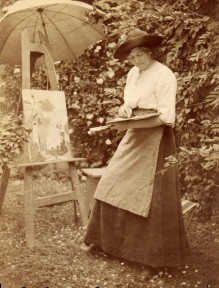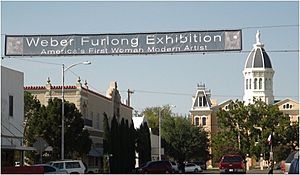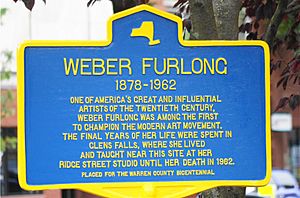Wilhelmina Weber Furlong facts for kids
Quick facts for kids
Wilhelmina Weber Furlong
|
|
|---|---|

Weber Furlong 1898 in Paris
|
|
| Born | November 24, 1878 |
| Died | May 25, 1962 (aged 83) |
| Nationality | German–American |
| Education | Art Students League |
| Known for | Painting |
| Movement | Modern art, abstract art, Fauvism, impressionism, post-impressionism, expressionism, cubism |
| Spouse(s) | Tomás Furlong (artist) |
| Patron(s) | Gertrude Stein, Etta Cone, Claribel Cone, Oliver Gould Jennings, Hyde Collection Museum, Tang Museum, Bolton Museum, Weber Furlong Foundation, Studio 98, Skidmore College |
Wilhelmina Weber Furlong (1878–1962) was an important German American artist and teacher. She was one of America's first avant-garde (new and experimental) modern painters. Weber Furlong helped start modern impressionistic and expressionistic still life painting. This happened at the start of the modernist movement in the 1900s.
Some people call her the first female modernist painter in American Modernism. Furlong faced challenges, like many women artists in the late 1800s and early 1900s. They often struggled against teachers who preferred realist art and did not support modern art or women artists.
Her Life as an Artist
Wilhelmina Weber Furlong had a long and busy art career from 1892 to 1962. She was a successful modern artist. She worked in many places like St. Louis, Mexico City, New York City, and Paris.
She began her art studies in 1892. Her teachers included famous artists like Emil Carlsen, William Merritt Chase, and Edmund H. Wuerpel. They taught her at the St. Louis School of Fine Arts. From 1897 to 1906, she lived in Paris, France. There, she went to the Salon d'Automne art show for three years. She met artists like Pablo Picasso and Paul Cézanne who also showed their art there.
From 1906 to 1913, Weber Furlong painted in Mexico City. After that, she moved to New York City. She lived and worked there until 1947. While in New York, she also spent time in the countryside. She had a farm called Golden Heart Farm in Glens Falls and Bolton Landing, New York. From 1952 to 1962, she invited other artists to stay and work at her farm.
In America, Weber Furlong knew many important artists. These included John Graham, Willem de Kooning, David Smith, and Edward Hopper. As a young woman, she studied at the Art Students League before 1900. In 1913, she became very active in the New York art scene. She worked as a Secretary Treasurer and a board member at the Art Students League. Her husband, the artist Tomás Furlong, was also involved. She taught art for over 56 years in New York. She was also active with the Whitney Studio Club when it was first starting.
Her Impact and Recognition
Weber Furlong had a strong connection with the sculptor David Smith in Bolton Landing, New York. She is known for bringing him to the farm he bought there with his wife, Dorothy Dehner. Her artworks are always on display at the Bolton Landing Museum.
The Hyde Collection in Glens Falls, New York, has shown Wilhelmina Weber Furlong's art since 1966. After she passed away in 1962, they held a big show just for her art. The Tang Museum at Skidmore College also owns a piece by Weber Furlong. This artwork has been shown in the area since 1952. In the early 1950s, Skidmore College in Saratoga Springs, New York, had solo shows of Weber Furlong's art for several years. She also showed her art with David Smith at the State Capital in Albany, New York.
In September 2012, the International Woman's Foundation in Marfa, Texas, held a major show of Weber Furlong's works. It featured over 75 pieces that had not been seen before. It also included some of her personal items, like her old easel. This show was at the famous Building 98 studio galleries. A professor named James K. Kettlewell, who used to be a curator at the Hyde Collection, gave a lecture there.

In Spring 2012, a documentary film was made about Wilhelmina Weber Furlong's life. It focused on her as an important early American woman modernist. You can see her art permanently at the Hyde Collection in Glens Falls, New York. Her work is also at the Bolton Landing, New York town history museum.
On August 7, 2012, the Crandall Public Library in Glens Falls, New York, hosted a film crew and a talk about Wilhelmina Weber Furlong. Professor James K. Kettlewell spoke there. They also showed one of her artworks that had been lost.

On July 23, 2013, the City of Glens Falls, New York, decided to put up a historical marker. It is in downtown Glens Falls near City Hall. The marker says: "Weber Furlong (1878–1962) One of America's great and influential artists of the twentieth century, Weber Furlong was among the first to champion the Modern art movement. The final years of her life were spent in Glens Falls, where she lived and taught near this site at her Ridge Street studio until her death in 1962. Placed for the Warren County Bicentennial."
Recent exhibitions of her work include:
- 2019: "Two Centuries of Art from Bolton Landing" at the Bolton Historical Society Museum in Lake George, New York.
- 2019: "Weber Furlong Her Life. Her Art. Her Legacy." in Dublin, Ireland. This show was put on by Clint Weber, Mona Blocker Garcia, and artist Martin De Porres Wright.
- 2022: "To Live is to Paint: Wilhelmina Weber Furlong, Dorothy Dehner and American Modernism" at The Art Students League of New York in Manhattan. This show explored the art journeys of Furlong and Dehner.
- 2022: Prizer Arts and Letters in Austin, Texas, featured Wilhelmina Weber Furlong. They noted how she worked hard to be taken seriously as an artist, even with challenges. She famously said, "To live is to paint."
See also
 In Spanish: Wilhelmina Weber Furlong para niños
In Spanish: Wilhelmina Weber Furlong para niños

